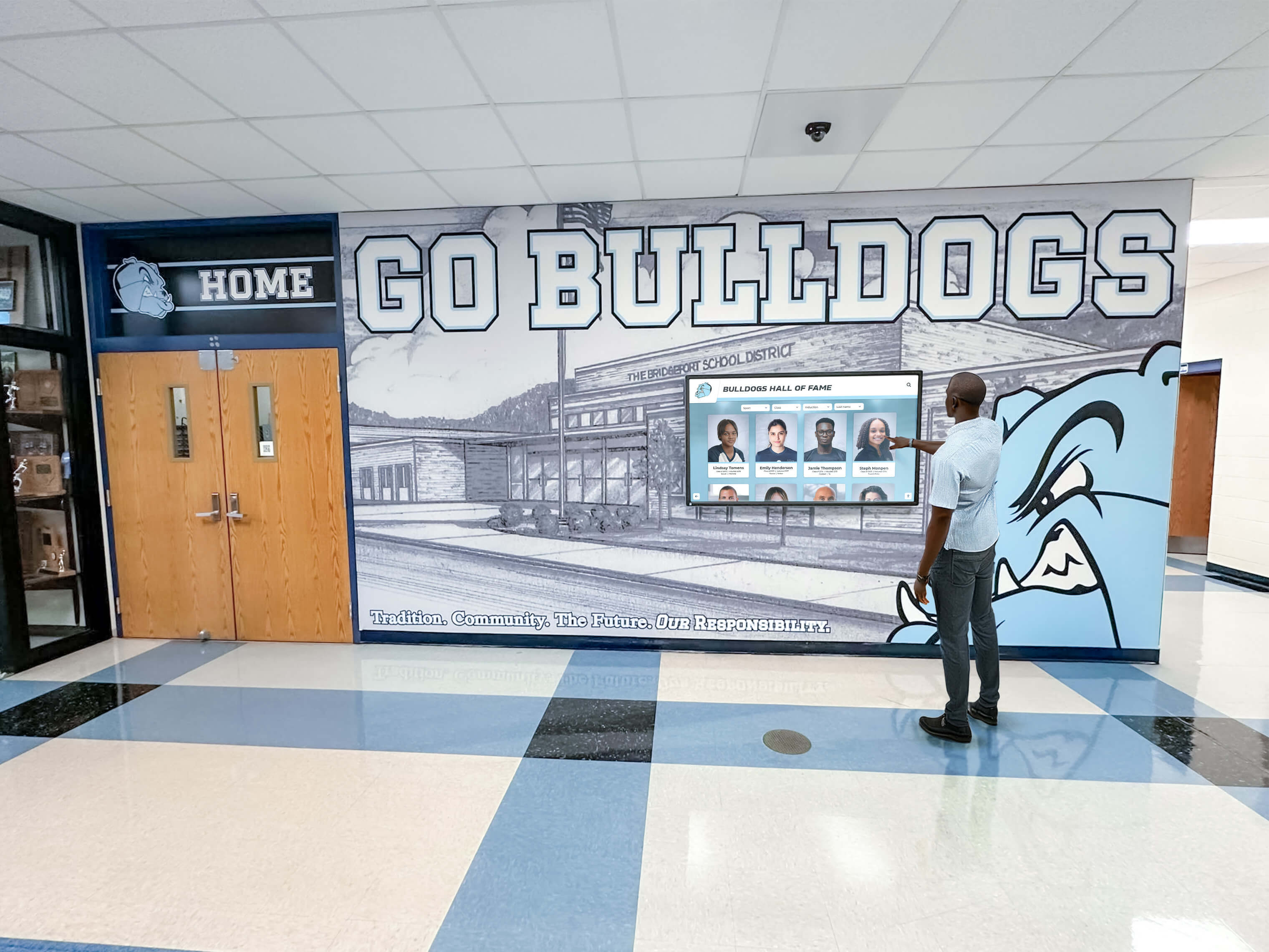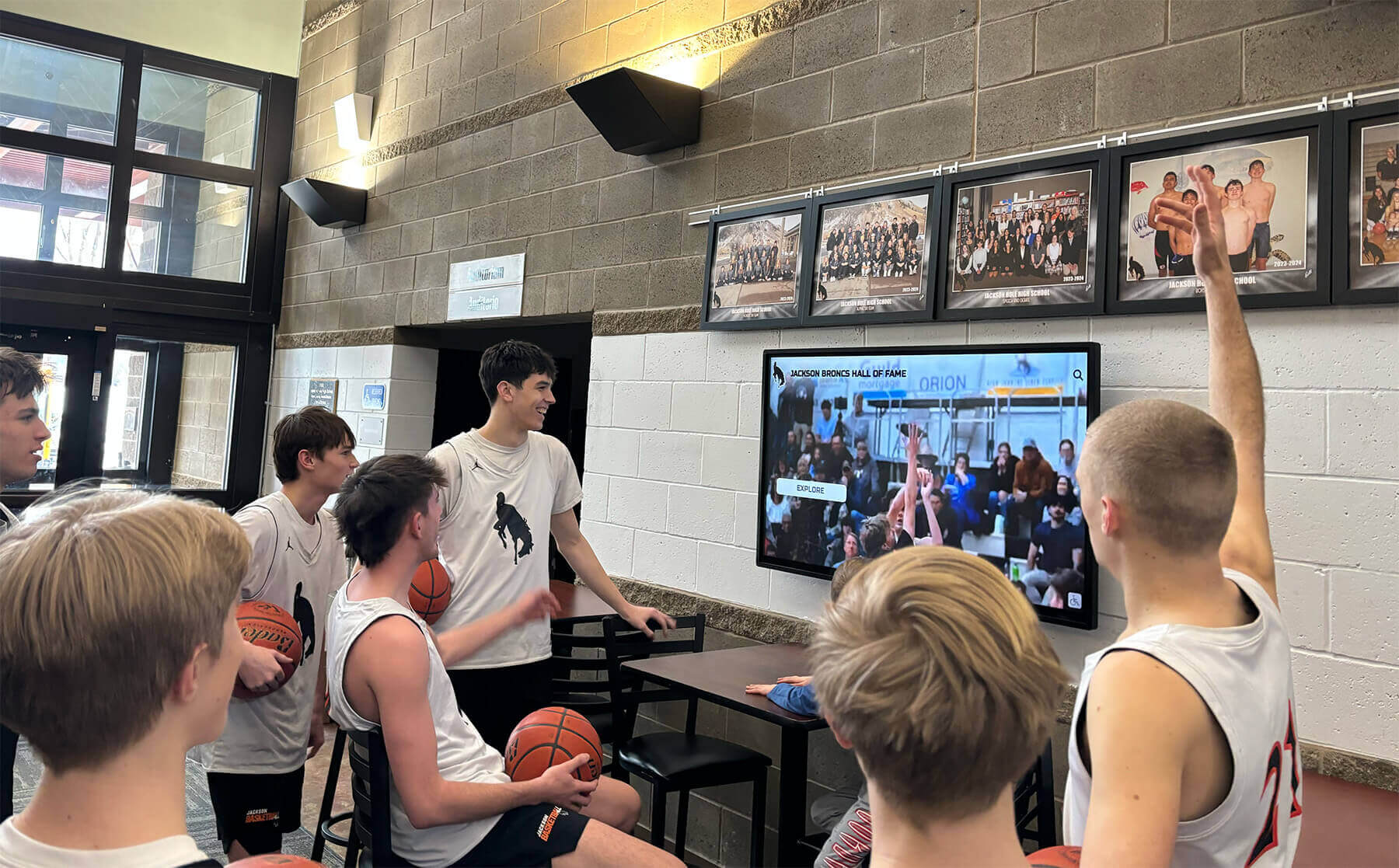Key Takeaways
Comprehensive guide to recognizing high school basketball captains. Learn effective selection criteria, recognition programs, and modern display solutions that celebrate team leadership and inspire future athletes.
The Vital Role of Basketball Captains in High School Programs
Understanding why basketball captains matter helps schools design recognition programs that appropriately honor this critical leadership position while communicating the qualities institutions value most.
Leadership Functions That Captains Fulfill
Effective basketball captains perform multiple essential functions that directly impact team performance and program culture:
On-Court Leadership and Communication:
During games, captains serve as coaches’ primary communication channels, relaying strategic adjustments, calling out defensive assignments, organizing offensive sets, and maintaining composure during challenging moments when emotions run high. This real-time leadership proves particularly valuable during timeouts when captains can quickly assess teammate mental states and deliver the messages that refocus attention or boost confidence heading into critical possessions.
Practice Standards and Accountability:
Perhaps captains’ most important role involves establishing and maintaining practice intensity standards. When captains arrive early, work hard throughout every drill, encourage maximum effort from teammates, and hold peers accountable for shortcuts or lackadaisical approaches, they create practice environments where excellence becomes the expected norm rather than occasional occurrence. Student recognition programs demonstrate how visible acknowledgment of leadership strengthens these cultural contributions.
Team Culture Development:
Captains significantly influence the values, attitudes, and behaviors that define team culture. Through their words but more importantly through consistent actions, captains teach younger players what your program stands for, how teammates should treat one another, what level of commitment the program expects, and how student-athletes should conduct themselves representing their schools. This culture-building function creates lasting program legacies that extend far beyond individual seasons.

The Impact of Strong Captain Leadership
Research on team dynamics and athletic performance consistently demonstrates that teams with effective captains achieve measurably better outcomes:
Performance Improvements:
Teams with strong captain leadership demonstrate better communication during games, faster in-game adjustments to opponent strategies, improved fourth-quarter performance when games are decided, higher free-throw percentages in pressure situations, and better execution of plays following timeouts—all indicators of the mental toughness and focus that effective leadership creates.
Program Culture Benefits:
Beyond wins and losses, captain influence shapes broader program culture through reduced behavioral issues and disciplinary problems, stronger academic performance among team members, better retention rates with fewer players quitting mid-season, enhanced family engagement as parents see positive leadership, and improved community reputation as programs become known for developing young leaders alongside athletic skills. These cultural benefits create sustainable excellence rather than occasional success.
Player Development Acceleration:
Quality captain leadership accelerates younger players’ development as captains mentor underclassmen about program expectations, provide encouragement during difficult learning curves, model proper technique and work ethic daily, offer peer perspective that complements coaching instruction, and create supportive team environments where mistakes become learning opportunities rather than sources of embarrassment or ridicule.
Establishing Fair Captain Selection Processes
Credible captain recognition begins with transparent selection processes ensuring this honor genuinely reflects leadership excellence rather than favoritism, seniority, or simply rewarding the most talented players.
Selection Criteria That Identify True Leaders
Effective captain selection considers multiple leadership dimensions rather than relying solely on any single factor:
Character and Integrity Demonstrations:
Outstanding captains consistently demonstrate integrity through honest communication even when difficult, taking responsibility for mistakes rather than blaming others, treating all teammates with respect regardless of status, maintaining composure during adversity and disappointment, and conducting themselves appropriately in all school and community settings. Character proves foundational because teammates won’t follow leaders they don’t respect regardless of athletic ability.
Communication Skills and Emotional Intelligence:
Effective captains possess strong communication abilities including articulating ideas clearly to diverse audiences, listening actively to understand teammates’ perspectives, reading emotional states and adjusting approaches accordingly, delivering constructive criticism that improves rather than discourages, and maintaining productive dialogue with coaching staff about team concerns. These communication skills enable captains to bridge gaps and build unity.
Basketball Knowledge and Strategic Understanding:
While captains need not be the most talented players, they should demonstrate solid basketball IQ through understanding offensive and defensive concepts, recognizing opponent tendencies and adjustments, making sound in-game decisions under pressure, explaining plays and strategies to confused teammates, and serving as de facto assistant coaches who extend staff knowledge throughout the roster.
Work Ethic and Commitment Level:
Captain credibility requires that leaders model the work ethic they expect from teammates through consistent practice attendance and punctuality, maximum effort regardless of drill or situation, voluntary extra work improving weaknesses, summer training commitment and off-season preparation, and balanced dedication to basketball alongside academics and other responsibilities. Student-athlete recognition demonstrates how celebrating work ethic builds cultures of excellence.
Selection Methods and Processes
Different selection approaches offer distinct advantages while addressing various program philosophies and circumstances:
Coach Selection Approach:
Many programs grant head coaches full captain selection authority, enabling them to choose players whose leadership styles align with program needs for specific seasons. This approach offers coaching staff complete control while ensuring captains possess qualities coaches value most. However, coach selection risks perceptions of favoritism or overlooking players that teammates respect even if coaches don’t recognize their influence.

Team Vote Methods:
Some coaches allow players to vote for captains, either giving players complete decision authority or using votes as significant input informing coaching decisions. Player votes ensure captains possess authentic teammate respect and peer credibility. Potential drawbacks include popularity contests selecting well-liked players who lack leadership capabilities, social dynamics discouraging votes for assertive leaders who hold peers accountable, and immature players making choices based on friendship rather than leadership qualities.
Hybrid Selection Processes:
Many successful programs use hybrid approaches combining coaching judgment with player input. Common models include:
- Team nominates, coach approves: Players nominate captain candidates through voting or discussion, then coaches make final selections from the nominee pool
- Weighted voting: Both players and coaches vote with predetermined weight given to each group (for example, player votes count 70% and coaching staff votes 30%)
- Interview-based selection: Coaches identify captain candidates, conduct formal interviews assessing leadership understanding, then make informed selections
- Trial captain periods: Multiple players serve as “captains for the week” during practices, enabling coaches and teammates to evaluate leadership in action before making permanent selections
Clear Communication of Selection Process:
Regardless of which approach programs use, transparently communicating selection processes before the season prevents confusion and accusations of unfairness. Players should understand exactly how captains will be selected, what criteria matter most in decisions, when selections will be announced, and why your program values the specific leadership qualities you’re seeking in team captains.
Timing Captain Selection and Announcements
Strategic timing of captain selection and public announcement affects how this honor influences team dynamics:
Pre-Season Selection Benefits:
Naming captains before official practices begin allows designated leaders to help establish practice culture from day one, participate in preseason team bonding and leadership development, develop relationships with new players and coaching staff before season pressure begins, and prepare mentally for leadership responsibilities before games commence. Early selection demonstrates that captain roles matter enough to warrant thoughtful advanced designation.
Mid-Season Selection Considerations:
Some programs delay captain designation until several weeks into the season, allowing coaches to observe players in competitive situations, enabling natural leaders to emerge through early-season challenges, avoiding premature selection of players who don’t live up to expectations, and ensuring captains possess current respect rather than reputation based on prior years. This wait-and-see approach provides better information but delays the culture-setting that early captain designation enables.
Multiple Captain Models:
Many programs designate multiple captains (typically 2-4) rather than single leaders, providing balanced leadership representing different perspectives and styles, reducing pressure on any individual to be perfect, allowing specialization where different captains handle specific leadership aspects, creating leadership development opportunities for multiple players, and preventing captain loss from injury or personal issues from eliminating team leadership entirely.
Creating Meaningful Captain Recognition Programs
Beyond initial selection, comprehensive recognition programs appropriately honor captain contributions while inspiring younger players to develop leadership qualities that might earn them similar recognition in future seasons.
Symbolic Recognition Elements
Traditional symbolic recognition helps captains feel the significance of their leadership roles:
Team Captain Designation Systems:
Physical indicators that identify captains to teammates, opponents, officials, and spectators include:
- Captain patches on uniforms during games
- Different colored practice jerseys or pinnies
- Special warm-up gear designated for captains
- Pre-game introductions highlighting captain status
- Captain designations on roster boards and programs
These visible markers reinforce that captain selection represents genuine honor while helping officials and opponents quickly identify team leaders during games.
Captain-Specific Ceremonies and Traditions:
Special ceremonies acknowledge captain designation significance through formal captain announcement events for families and supporters, ceremonial passing of captain responsibilities from senior to junior leaders, pre-season captain oath taking where new leaders formally commit to their responsibilities, senior night special recognition of departing captain leadership, and post-season captain reflection presentations where they share leadership lessons learned. These ceremonies demonstrate institutional respect for leadership while creating memorable experiences.
Leadership Development Opportunities:
Effective programs don’t simply name captains then expect natural leadership emergence—they provide development support through leadership workshop attendance addressing communication and conflict resolution, mentorship from successful former team captains, access to leadership books and resources, meetings with school administrators and community leaders, and formal evaluation and feedback sessions helping captains continuously improve. This investment demonstrates genuine commitment to developing leaders rather than simply designating titles.

Digital Recognition Displays for Captain Honor
Modern digital recognition systems enable comprehensive captain celebration that traditional plaques cannot match:
Comprehensive Captain Profiles:
Digital displays allow detailed captain recognition including professional photographs showcasing leadership moments, career statistics and team accomplishments during their tenure, written narratives describing specific leadership contributions, video highlights of on-court performance and leadership, quotes from coaches and teammates about their impact, and post-graduation updates showing continued success and school connections. This rich multimedia content celebrates captains comprehensively while inspiring younger players.
Interactive Exploration Features:
Unlike static plaques, interactive touchscreen displays enable visitors to search captain names and specific years, filter by various criteria and accomplishment types, browse photo galleries showing captains throughout program history, watch video content when available, and share captain profiles through social media. This interactivity creates engagement that passive displays never achieve.
Unlimited Capacity and Permanent Archives:
Digital systems accommodate unlimited captain recognition regardless of how many years or leaders your program honors. Every captain from program history receives appropriate recognition without space constraints that force difficult decisions about which leaders to feature. Additionally, digital archives preserve captain recognition permanently, allowing alumni to revisit their leadership years long after graduation while enabling current players to explore complete program leadership history.
Easy Updates and Current Season Integration:
Cloud-based content management systems enable staff to add new captains immediately after selection, update profiles throughout seasons as accomplishments occur, modify content correcting errors or adding information, and schedule future updates in advance. This ease of management ensures recognition remains current rather than becoming outdated displays reflecting past glory but ignoring present success.
End-of-Season Captain Recognition
Formal season-end recognition appropriately celebrates captain contributions once their leadership tenures conclude:
Senior Captain Awards and Ceremonies:
Graduating captains merit special recognition through senior night ceremonies honoring departing leaders, special awards recognizing specific captain contributions, gifts or commemorative items celebrating their service, recognition in team banquets and year-end events, and permanent recognition on athletic walls of honor preserving their leadership legacy. This formal conclusion to captain service provides meaningful closure while demonstrating how much their leadership mattered to programs.
Underclass Captain Continuing Recognition:
Captains who return for additional seasons deserve recognition of their extended leadership through acknowledgment of multiple-year captain status, leadership growth and development over time, mentorship of new captains joining leadership teams, and continued profile updates reflecting additional accomplishments. Recognizing sustained captain service encourages the long-term leadership commitment that strengthens programs.
Team Impact Documentation:
Beyond individual captain recognition, programs should document team outcomes during captain tenures including season records and competitive success, team statistical achievements and improvements, individual player development under their leadership, program culture changes they influenced, and community service or charitable initiatives they led. This outcome documentation demonstrates concrete leadership impact rather than simply celebrating the captain title itself.

Best Practices for Captain Recognition That Inspires Excellence
Successful captain recognition programs share common characteristics that maximize impact while avoiding potential pitfalls:
Balance Honor with Expectations
Recognition programs should celebrate captain leadership while maintaining high standards:
Emphasize Responsibility Alongside Honor:
While captain selection represents genuine honor deserving celebration, recognition should always emphasize the significant responsibilities captains assume. Avoid creating perceptions that captaincy primarily confers status or privileges—instead, communicate that captain designation requires elevated commitment, consistent leadership demonstration, and willingness to put team needs ahead of personal preferences. This responsibility-focused framing attracts mature leaders while discouraging players seeking titles without understanding accompanying obligations.
Maintain Performance Accountability:
Captain status should never excuse poor behavior, lackadaisical effort, or conduct inconsistent with program values. Programs must be willing to remove captain designation when leaders fail to meet behavioral expectations, regardless of athletic talent or seniority. Maintaining high standards preserves captain honor while teaching important lessons about leadership accountability. Documentation of character recognition provides frameworks for celebrating integrity alongside achievement.
Create Inclusive Leadership Development
While not all players can be captains, effective programs ensure all team members receive leadership development opportunities:
Leadership Roles Beyond Captains:
Distribute leadership responsibilities throughout rosters through designated roles including team managers with specific organizational responsibilities, drill leaders who run specific practice activities, scout team captains leading practice opponents, social chairs organizing team bonding events, and academic liaisons supporting teammate classroom success. These distributed roles develop diverse leadership skills while preventing captain monopolization of all leadership opportunities.
Underclassman Leadership Pipeline:
Intentionally develop younger players’ leadership capabilities through pairing freshmen and sophomores with upperclass mentors, providing leadership reading materials and discussion opportunities, involving underclassmen in team decisions appropriate for their maturity, recognizing emerging leadership demonstrations, and explicitly discussing long-term leadership development as program objective. This pipeline approach ensures continuous leadership development rather than scrambling to identify captains each season.
Celebrate Leadership Alongside Athletic Excellence
Recognition programs should honor leadership qualities with prominence equal to athletic achievements:
Prominent Leadership Recognition Displays:
Leadership recognition should receive visibility matching athletic achievement displays. When digital record boards prominently showcase statistical records while captain recognition occupies secondary space, programs implicitly communicate that scoring points matters more than leading teammates. Balanced recognition demonstrates genuine commitment to developing complete student-athletes rather than simply elite performers.
Captain Stories and Narratives:
Go beyond simply listing captain names with dates—share compelling stories that illustrate specific leadership moments and impacts. These narratives might describe how captains responded during adversity, specific instances where they positively influenced teammates, challenging situations where their leadership proved crucial, or character demonstrations that embodied program values. Story-based recognition creates emotional connection while teaching leadership lessons more effectively than simple name lists.
Alumni Captain Connections:
Connect current captains with successful former team leaders through mentorship programs pairing new captains with alumni leaders, alumni speaker events where former captains share leadership experiences, regular communication maintaining captain network connections, and reunion events bringing together captains across generations. These connections demonstrate that captain recognition creates lasting bonds while providing current leaders with valuable perspective and support.

Implementing Captain Recognition in Your Basketball Program
Moving from concept to reality requires systematic planning that addresses potential challenges while building sustainable recognition programs:
Establishing Your Captain Recognition Philosophy
Before implementing specific recognition approaches, clarify your program’s captain philosophy:
Define Captain Purpose and Expectations:
Document exactly what captain selection means in your program including specific leadership responsibilities captains assume, behavioral and performance standards captains must maintain, time commitments beyond regular practice and games, authority captains possess regarding team decisions, and support coaches provide to help captains succeed. Clear documentation prevents confusion while establishing consistent expectations across seasons.
Determine Selection Approach:
Based on your program’s culture, coaching philosophy, and team dynamics, select the captain designation method that best serves your specific circumstances. Consider factors including team maturity levels and decision-making capability, program’s leadership development history and traditions, specific season challenges requiring particular leadership styles, and administrative support for your chosen approach. Document your selection process and share it transparently with all stakeholders.
Plan Recognition Budget:
Estimate costs for implementing your captain recognition program including any physical recognition elements (patches, special gear, plaques), ceremony expenses for captain designation and season-end recognition, digital recognition system investment if implementing technology solutions, leadership development resources and training programs, and ongoing maintenance and updates. Secure necessary funding through athletic department budgets, booster organization support, or specific fundraising if needed.
Creating Recognition Content
Quality recognition requires gathering and organizing appropriate information:
Captain Information Collection:
Systematically collect comprehensive information about each captain including biographical details and family information, complete playing career statistics and accomplishments, specific leadership contributions and memorable moments, quotes from coaches, teammates, and community members, photographs from games, practices, and team events, video content when available, and post-graduation updates as alumni remain connected. Thorough information collection enables rich recognition profiles rather than basic name-and-date listings.
Historical Captain Research:
If implementing comprehensive recognition including past leaders, research historical captains through reviewing old yearbooks and school publications, interviewing long-time coaches and community members, consulting program records and archives, connecting with alumni associations for assistance, and gathering photographs and memorabilia when available. This historical research preserves program legacy while honoring leaders who might otherwise be forgotten.
Maintaining Recognition Programs Long-Term
Recognition sustainability requires ongoing attention preventing programs from becoming neglected installations:
Annual Recognition Updates:
Establish predictable processes for adding new captains annually including end-of-season information collection, summer content creation and preparation, pre-season recognition updates going live, and beginning-of-season announcement and celebration. Systematic processes prevent recognition from falling behind or becoming sporadic rather than consistent.
Recognition Program Assessment:
Periodically evaluate recognition program effectiveness through gathering feedback from captains about their experiences, surveying players about recognition program impact on motivation, collecting input from coaching staff about leadership development, assessing family and community response to recognition, and tracking correlation between strong captain leadership and team success. Regular assessment enables continuous improvement rather than assuming programs remain effective without verification.
Technology Platform Maintenance:
For programs using digital recognition systems, maintain platforms through regular software updates and feature enhancements, periodic content audits ensuring accuracy and currency, backup systems protecting against content loss, user training for staff managing content updates, and vendor relationships ensuring ongoing technical support. Proper maintenance preserves technology investments while ensuring recognition systems continue functioning reliably.
Conclusion: Celebrating Leadership That Defines Basketball Excellence
Basketball captain recognition represents far more than adding names to plaques or listing leaders in programs—it embodies institutional commitment to developing and celebrating the leadership qualities that distinguish memorable programs from forgettable teams. When high schools implement thoughtful captain selection processes that identify genuine leaders rather than simply designating titles, provide meaningful recognition that honors leadership alongside athletic achievement, and create comprehensive programs celebrating captains’ contributions while inspiring future leaders, they build sustainable excellence cultures where leadership development receives appropriate emphasis.
The most effective captain recognition programs share essential characteristics: they establish clear selection criteria emphasizing character and commitment rather than simply rewarding talent, provide prominent recognition through modern platforms enabling comprehensive celebration, balance honoring captains with maintaining high behavioral expectations, develop leadership capabilities across entire rosters rather than focusing exclusively on designated leaders, and preserve program leadership history through permanent recognition that connects current athletes with those who established excellence traditions.
Modern digital recognition solutions from Rocket Alumni Solutions enable schools to create comprehensive captain recognition that traditional static displays cannot match. These interactive platforms provide unlimited capacity for honoring every captain throughout program history, enable rich multimedia storytelling celebrating specific leadership contributions, create engaging experiences that inspire younger players to pursue captain qualities, and offer easy content management ensuring recognition remains current as new leaders emerge each season.
Whether your program names single captains or leadership teams, selects captains before seasons or during competitive play, emphasizes continuity through multi-year leaders or develops new captains annually, the fundamental importance remains constant: basketball captains significantly influence program culture, competitive success, and individual player development. Recognizing these leaders appropriately demonstrates what your program values while inspiring the next generation of student-athletes to develop the character, commitment, and communication skills that define exceptional team leadership.
Begin building your basketball captain recognition program today—your current captains, future leaders, and entire program community will benefit from appropriately celebrating the leadership that transforms good teams into great ones and average programs into examples of sustained excellence.





































